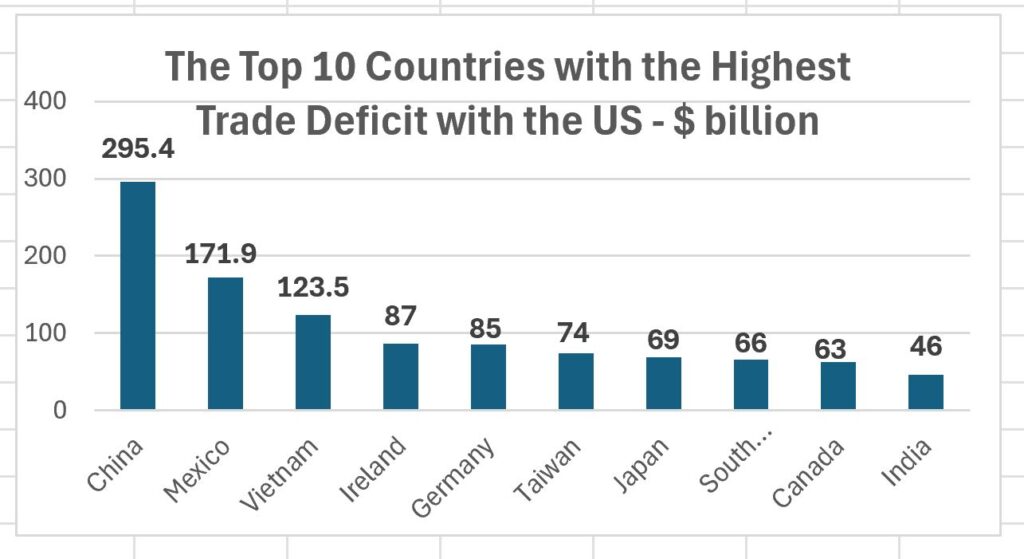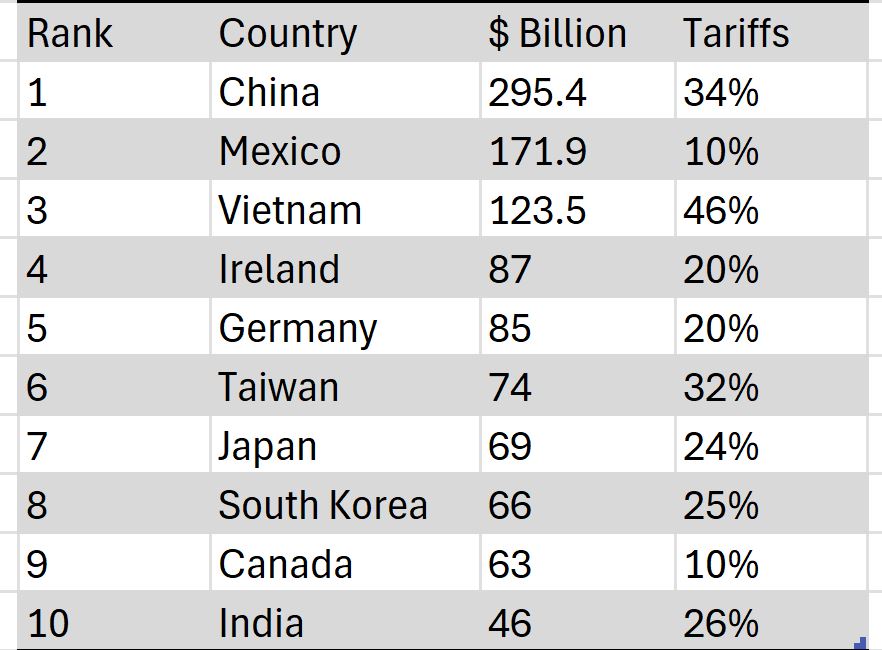The Economic Implications of U.S. Tariffs on Key Trading Partners

On April 2, 2025, President Donald Trump announced a series of new tariffs designed to address trade imbalances and bolster domestic manufacturing. These measures include a universal baseline tariff of 10% alongside higher, country-specific “reciprocal” tariffs aimed at nations with substantial trade surpluses with the U.S.
These newly imposed tariffs carry significant economic consequences, particularly for the top ten U.S. trading partners with the highest trade deficits. These nations—China, Mexico, Vietnam, Ireland, Germany, Taiwan, Japan, South Korea, Canada, and India—account for a collective trade imbalance worth hundreds of billions of dollars, as detailed in the table below. In light of these tariffs, each of these countries must carefully evaluate their response, balancing economic stability with strategic geopolitical considerations. Their potential courses of action can be categorized into three primary strategies, each with distinct economic ramifications.


The top 10 countries with the highest trade deficits.
1. Retaliatory Tariffs: A Counterproductive Strategy
One possible reaction from these trading partners is to impose reciprocal tariffs on U.S. goods. While this response might seem like a logical countermeasure, it risks economic self-sabotage. For instance, China, which holds the highest U.S. trade deficit at $295.4 billion and faces a 34% tariff, could retaliate by increasing levies on American exports. However, such a move could limit the availability of leading U.S. brand names and products within their domestic markets, potentially driving public dissatisfaction and fostering black-market activities. Given the strong consumer preference for U.S. brands worldwide, this approach could disrupt supply chains and undermine economic stability in these countries. More importantly, these nations cannot afford to lose access to the largest consumer market in the world—the United States. Cutting off trade with the U.S. would significantly hinder economic growth, reduce employment opportunities, and create financial instability.
2.Diversification of Trade Alliances: A Limited Solution
Another strategic alternative is for these nations to form new trade alliances with other countries to satisfy their demand for goods and services. Mexico, for example, which faces a 10% tariff despite being the second-largest contributor to the U.S. trade deficit at $171.9 billion, may seek to expand trade with European or Asian economies. Vietnam, which faces a steep 46% tariff, could also pursue alternative markets. However, this strategy presents limitations. The United States continues to exert a strong cultural and economic influence globally, making it difficult for other nations to fully substitute American goods and services. Furthermore, the rapid reorientation of trade networks would require extensive adjustments in logistics, regulatory frameworks, and consumer preferences, leading to inefficiencies and higher costs. Even if alternative trading partners are found, they may not match the scale, purchasing power, and market stability that the U.S. provides.
3.Negotiation and Tariff Reduction: The Rational Choice
The most economically viable option is for these countries to engage in negotiations with the United States to reduce tariffs and seek mutually beneficial trade terms. For example, Japan and Germany—facing 24% and 20% tariffs, respectively—may find that maintaining access to the U.S. market is crucial for their automotive and industrial sectors. Similarly, India, which carries a $46 billion trade deficit with the U.S. and faces a 26% tariff, may opt for diplomatic negotiations to sustain economic growth. Given the significant role that trade with the U.S. plays in their economies, the inability to access the American market could result in economic contractions, loss of employment, and potential political instability. Negotiation remains the most practical and sustainable solution to mitigate economic disruptions and maintain trade flows.
The Macroeconomic Impact: Transitory Inflation and Market Adjustment
The imposition of tariffs is expected to create short-term inflationary pressures as import costs rise. Countries such as Taiwan and South Korea, with 32% and 25% tariffs, respectively, may experience increased production costs, which could drive inflation in both their domestic markets and the U.S. However, market dynamics suggest that these disruptions will likely be transitory. Businesses and policymakers will seek corrective measures to stabilize the economy, either through trade negotiations or domestic adjustments in supply chains. Ultimately, market forces are expected to recalibrate, leading to a stabilization of price levels and trade dynamics.
Conclusion
While the implementation of tariffs may introduce short-term economic volatility, the long-term outcome will likely depend on the strategic responses of these trading partners. Given the global economic interdependence and the strong presence of American brands worldwide, the most rational response for these nations is to engage in trade negotiations rather than adopt counterproductive retaliatory measures. More importantly, with the U.S. serving as the largest and most lucrative consumer market, no country can afford to sever trade ties without severe economic consequences. As a result, these nations will inevitably seek to negotiate with the U.S. to secure favorable trade terms. Consequently, while tariffs may cause a temporary inflationary surge, market mechanisms and diplomatic efforts will likely lead to stabilization in global trade sooner rather than later.

